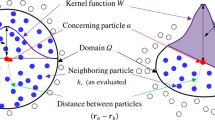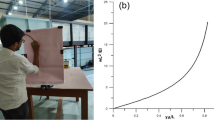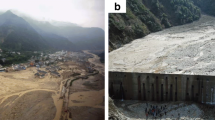Abstract
Finite Element Method (FEM) and Smoothed Particle Hydrodynamics (SPH) method are effective methods to study the interaction between marine structures and sea ice. However, both FEM and SPH methods have their own shortcomings in numerical simulations. There are mesh distortions and disappearance in FEM, and tensile instability, difficulty in applying boundary conditions, and low computational efficiency in SPH. Thus, to make up those problems, it is essential to develop a new numerical method. In the present study, the FEM–SPH adaptive method was applied in the numerical simulation of icebreaking, which could convert finite elements into SPH particles based on given conditions. Numerical models of cone and icebreaker interactions with level ice were established. Then, numerical simulation results were compared with empirical formula and model test results. In addition, the effects of cone angle and ice strength were analyzed. It was demonstrated that this algorithm could accurately predict the icebreaking resistance, which is the most concerned parameter in practice. Simultaneously, it could effectively simulate the accumulation process of ice rubbles. Thus, the FEM–SPH adaptive method is considered to be an effective way to simulate the interaction between marine structures and sea ice, and has great potential in the numerical simulation of icebreaking.




















Similar content being viewed by others
References
Gautier DL, Bird KJ, Charpentier RR, Grantz A, Houseknecht DW, Klett TR, Moore TE, Pitman JK, Schenk CJ, Schuenemeyer JH, Sørensen K, Tennyson ME, Valin ZC, Wandrey CJ (2009) Assessment of undiscovered oil and gas in the Arctic. Science 324(5931):1175–1179
Akimova I (2019) Development of the Arctic and its impact on international energy market. Society of Petroleum Engineers. In: SPE Middle East Oil and Gas Show and Conference, Manama, Bahrain, March 18–21
Cavalieri DJ, Parkinson CL (2012) Arctic sea ice variability and trends, 1979–2010. Cryosphere 6(4):881–889
Stroeve J, Notz D (2018) Changing state of Arctic sea ice across all seasons. Environ Res Lett 13(10):103001
Vaughan DG, Comiso JC, Allison I, Carrasco J, Kaser G, Kwok R, Mote P, Murray T, Paul F, Ren J, Rignot E, Solomina O, Steffen K, Zhang T (2013) Observations: cryosphere. In: climate change 2013: the physical science basis. Contribution of Working Group I to the Fifth Assessment Report of the Intergovernmental Panel on Climate Change. Cambridge University Press, Cambridge, United Kingdom and New York, NY, USA
Bridges R, Riska K, Lu L, Du-Couedic-De-Kererant M, Aubert JM (2018) A study on the specification of minimum design air temperature for ships and offshore structures. Ocean Eng 160:478–489
Dehghani-Sanij AR, Dehghani SR, Naterer GF, Muzychka YS (2017) Sea spray icing phenomena on marine vessels and offshore structures: review and formulation. Ocean Eng 132:25–39
Necci A, Tarantola S, Vamanu B, Krausmann E, Ponte L (2019) Lessons learned from offshore oil and gas incidents in the Arctic and other ice-prone seas. Ocean Eng 185:12–26
Bjerkås M (2007) Review of measured full scale ice loads to fixed structures. In: International Conference on Offshore Mechanics and Arctic Engineering. San Diego, California, USA, June 10–15
Barker A, Timco G, Gravesen H, Vølund P (2005) Ice loading on Danish wind turbines: Part 1: dynamic model tests. Cold Reg Sci Technol 41(1):1–23
Brown TG, Tibbo JS, Tripathi D, Obert K, Shrestha N (2010) Extreme ice load events on the confederation bridge. Cold Reg Sci Technol 60(1):1–14
Khan B, Khan F, Veitch B (2019) A cellular automation model for convoy traffic in Arctic waters. Cold Reg Sci Technol 164:102783
Kuutti J, Kolari K, Marjavaara P (2013) Simulation of ice crushing experiments with cohesive surface methodology. Cold Reg Sci Technol 92:17–28
Liu Z, Amdahl J, Løset S (2011) Plasticity based material modelling of ice and its application to ship–iceberg impacts. Cold Reg Sci Technol 65(3):326–334
Xue YZ, Liu RW, Li Z, Han DF (2020) A review for numerical simulation methods of ship–ice interaction. Ocean Eng 215:107853
Su B, Riska K, Moan T (2010) A numerical method for the prediction of ship performance in level ice. Cold Reg Sci Technol 60(3):177–188
Su B, Riska K, Moan T (2011) Numerical simulation of local ice loads in uniform and randomly varying ice conditions. Cold Reg Sci Technol 65(2):145–159
Zhou L, Su B, Riska K, Moan T (2012) Numerical simulation of moored structure station keeping in level ice. Cold Reg Sci Technol 71:54–66
Gagnon RE, Derradji-Aouat A (2006) First results of numerical simulations of bergy bit collisions with the CCGS terry fox icebreaker. In: Proc. of the 18th IAHR International Symposium on Ice
Derradji-Aouat A (2005) Explicit FEA and constitutive modelling of damage and fracture on polycrystalline ice—simulations of ice loads on offshore structures. In: Proceedings of the 18th International Conference on Port and Ocean Engineering under Arctic Conditions. Postdam, NY, USA: Clarkson University, 225–238
Wang C, Ren HL, Li H, Wang JF, Zhai SS (2015) A direct assessment method for structure strength of icebreaker based on numerical simulation. J Coastal Res 72(10073):548–553
Lucy LB (1977) A numerical approach to the testing of the fission hypothesis. Astron J 1013–1024
Gingold RA, Monaghan JJ (1977) Smoothed particle hydrodynamics: theory and application to non-spherical stars. Mon Not R Astron Soc 181(3):375–389
Zhang XY, Shi Y, Pan G, Huang QG (2020) Study on the impact performance of sandwich hollow cylinders hitting water based on SPH method. Ocean Eng 197:106808
Zhang NB, Zheng X, Ma QW, Hu ZD (2019) A numerical study on ice failure process and ice-ship interactions by Smoothed Particle Hydrodynamics. Int J Nav Arch Ocean 11(2):796–808
Qi YW (2016) SPH-based simulation analysis ship-ice interactions, Master thesis, Harbin Engineering University
Bian GF (2019) Research on the action process of sea ice and marine structures based on SPH-FEM coupling method, Master thesis, Harbin Engineering University
Belytschko T, Liu WK, Moran B, Elkhodary KI (2013) Nonlinear finite elements for continua and structures (2nd edn). New York, USA
Zhang ZC, Qiang HF, Gao WR (2011) Application of SPH-FEM contact algorithm in impact dynamics simulation. Chin J Sol Mech 32(3):319–324 ((in Chinese))
Monaghan JJ (2000) SPH without a tensile instability. J Comput Phys 159(2):290–311
Monaghan JJ (2005) Smoothed particle hydrodynamics. Rep Prog Phys 68:1703–1759
Johnson GR, Petersen EH, Stryk R (1993) Incorporation of an SPH option into the EPIC code for a wide range of high velocity impact computations. Int J Impact Eng 14(1–4):385–394
Johnson GR, Stryk RA, Beissel SR, Holmquist TJ (2002) An algorithm to automatically convert distorted finite elements into meshless particles during dynamic deformation. Int J Impact Eng 27(10):997–1013
Johnson GR, Stryk RA (2003) Conversion of 3D distorted elements into meshless particles during dynamic deformation. Int J Impact Eng 28(9):947–966
Zhang ZC, Qiang HF, Gao WR (2011) Conversion of 3D distorted finite elements into SPH particles during impact dynamic deformation. J Xi’an Jiaotong Univ 45(1):105–110 ((in Chinese))
Gao YD, Zhou T (2017) Numerical simulation and analysis for bit impact on pyrites based on 3D FEM-SPH conversion algorithm. J China Coal Soc 42(S2):568–575 ((in Chinese))
Gao YD, Wu WX (2020) Influence analysis of gangue layer on bit of shearer based on FEM-SPH algorithm. Coal Mine Mach 41(01):78–81 ((in Chinese))
He QG, Chen XW, Chen JF (2020) Finite element-smoothed particle hydrodynamics adaptive method in simulating debris cloud. Acta Astronaut 175:99–117
Düchting N (2018) Combined FEM-SPH simulations for ice in compression, Master thesis, Hamburg University of Technology
Chen Z, He YP, Huang C, Ren YP, Wu M (2020) Numerical simulation of sloping structure-level ice interaction based on SPH-FEM conversion algorithm. In: Proceedings of the 30th International Ocean and Polar Engineering Conference, Shanghai, China
International Organization for Standardization (2010) ISO/FDIS 19906:2010(E). Petroleum and natural gas industries—Arctic offshore structures
Croasdale KR (1980) Ice forces on fixed, rigid structures. Cold Regions Research and Engineering Laboratory Special Report No. 80–26
Croasdale KR, Cammaert AB (1994) An improved method for the calculation of ice loads on sloping structures in first-year ice. Hydrotech Construct 28(3):174–179
Lindqvist G (1989) A straightforward method for calculation of ice resistance of ships. In: Proceedings of the 10th International Conference on Port and Ocean Engineering under Arctic Conditions, POAC’89, Lulea, Sweden
Myland D, Ehlers S (2016) Influence of bow design on ice breaking resistance. Ocean Eng 119:217–232
Das J, Polić D, Ehlers S, Amdahl J (2014) Numerical simulation of an ice beam in four-point bending using SPH. In: International Conference on Offshore Mechanics and Arctic Engineering. American Society of Mechanical Engineers
Sazidy M S (2015) Development of velocity dependent ice flexural failure model and application to safe speed methodology for polar ships, Doctor thesis, Memorial University of Newfoundland
Wang F, Zou ZJ, Zhou L, Ren YZ, Wang SQ (2018) A simulation study on the interaction between sloping marine structure and level ice based on cohesive element model. Cold Reg Sci Technol 149:1–15
Bjerkås M, Alsos HS, Meese A (2013) Ice induced vibrations-observations of a full scale lock-in event. In: The Twenty-third International Offshore and Polar Engineering Conference. International Society of Offshore and Polar Engineers
Myland D, Ehlers S (2017) Methodology to assess the floe size and distribution along a ship hull during model scale ice tests for self-propelled ships sailing ahead in level ice. Ships Offshore Struct 12(sup1):S100–S108
Zhou L, Riska K, und Polach RB, Moan T, Su B (2014) Ice model test of an icebreaking tanker with fixed drift angles in level ice. In: Proceedings of the HYDRALAB IV Joint User Meeting, Lisbon
Acknowledgements
This work is financially supported by the Oceanic Interdisciplinary Program of Shanghai Jiao Tong University (NO. SL2020ZD101).
Author information
Authors and Affiliations
Corresponding author
Additional information
Publisher's Note
Springer Nature remains neutral with regard to jurisdictional claims in published maps and institutional affiliations.
About this article
Cite this article
Chen, Z., He, Y., Gu, Y. et al. A novel method for numerical simulation of the interaction between level ice and marine structures. J Mar Sci Technol 26, 1170–1183 (2021). https://doi.org/10.1007/s00773-021-00799-w
Received:
Accepted:
Published:
Issue Date:
DOI: https://doi.org/10.1007/s00773-021-00799-w




